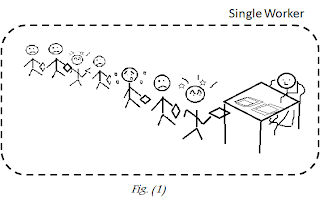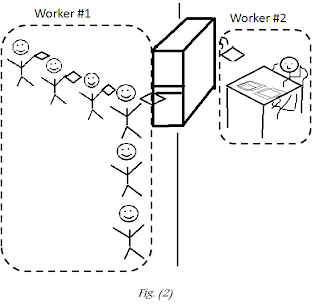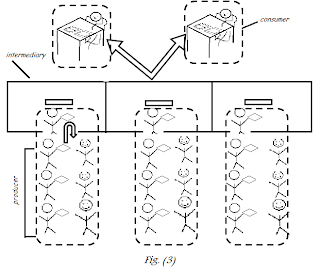Concurrency Pattern: Producer and Consumer
When I first heard the problem statement, I knew instantly what was needed. However, my approach to doing it this time was going to be different from last time. It had simply to do with how I am viewing technology in my life today. I will not go into any non-technical side and will jump straight into the problem and its solution. I started to look at what existed in the market and did come across a couple of posts that helped me in channelizing my thoughts in the right way.
Problem Statement
We need a solution for a batch migration. We are migrating data form System 1 to System 2 and in the process we need to do three tasks:
- Load data from Database based on groups
- Process the data
- Update the records loaded in step#1 with modifications
We have to handle 100s of groups and each group will have around 40K records. You can imagine the amount of time it would take if we were to perform this exercise in a synchronous fashion. Image here explains this problem in an effective way.
 |
| Producer Consumer: The Problem |
Producer and Consumer Pattern
Let us take a look at the Producer Consumer pattern to begin with. If you refer to the problem statement above and look at the image, we see that there are so many entities who are ready with their part of data. However, there are not enough workers who can process all the data. Hence, as the producers continue to line-up in a queue it just continues to grow. We see that the systems start to hog up threads and take a lot of time.
Intermediate Solution
 |
| Producer Consumer: The Intermediate approch |
We do have an intermediate solution. Refer to the image and you will immediately notice that the producers are piling up their work in a filing cabinet and the worker continues to pick it up as they get done with the previous task. However, this approach does have some glaring shortcomings:
- There is still one worker who has to do all the work. The external systems may be happy, but the task will still continue to exist until the worker has completed all of the tasks
- The producers will pile up their data in a queue and it needs resources to hold the same. Just as in this example the cabinet can fill up, the same can happen with the JVM resources too. We need to be careful how much data we are going to place in memory and in some cases it may not be much.
The Solution
 |
| Producer Consumer: The Solution |
The solution is what we see everyday in many places – like the cinema hall queue, Petrol Pumps etc. There are so many people who come in to book a ticket and based on how many people come in, the more people are added to issue tickets. Essentially, refer to image here and you will notice that Producers will keep adding their jobs to the cabinet and we have more workers to handle the work load.
Java provided concurrency package to solve this issue. Till now, I have always worked on threading at a much lower level and this was first time I was going to work with this package. As I started to explore the web and read fellow bloggers with what they have to say, I came across one very good article. It helped in understanding the use of BlockingQueue in a very effective manner. However, the solutions provided by Dhruba would not have helped me in achieving the high throughput which is needed. So, I started to explore the use of ArrayBlockingQueue for the same.
The Controller
This is the first class where the contract between the producers and consumers are managed. The controller will setup 1 thread for the Producer and 2 threads for the consumer. Based on the needs we can create as many threads as we need; and even can even read the data from a properties or do some dynamic magic. For now, we will keep this simple.
package com.kapil.techieforever.producerconsumer;
import java.util.concurrent.ExecutorService;
import java.util.concurrent.Executors;
import java.util.concurrent.Future;
public class TestProducerConsumer
{
public static void main(String args[])
{
try
{
Broker broker = new Broker();
ExecutorService threadPool = Executors.newFixedThreadPool(3);
threadPool.execute(new Consumer("1", broker));
threadPool.execute(new Consumer("2", broker));
Future producerStatus = threadPool.submit(new Producer(broker));
// this will wait for the producer to finish its execution.
producerStatus.get();
threadPool.shutdown();
}
catch (Exception e)
{
e.printStackTrace();
}
}
}
I am using ExecuteService to create a thread pool and manage it. Instead of using the basic Thread implementation, this is a more effective way as it will handle the exiting and restarting the threads as needed. You will also notice that I am using Future class to get the status of the producer thread. This class is very effective and will halt my program from further execution. This is a nice way of replacing the “.join” method on the threads. Note: I am not using Future very effectively in this example; so you may have to try a few things as you feel fit.
Also, you should note the Broker class which is being used as filing cabinet between the producers and consumers. We will see its implementation in just a little while.
The Producer
This class is responsible for producing the data that needs to be worked upon.
package com.kapil.techieforever.producerconsumer;
public class Producer implements Runnable
{
private Broker broker;
public Producer(Broker broker)
{
this.broker = broker;
}
@Override
public void run()
{
try
{
for (Integer i = 1; i < 5 + 1; ++i)
{
System.out.println("Producer produced: " + i);
Thread.sleep(100);
broker.put(i);
}
this.broker.continueProducing = Boolean.FALSE;
System.out.println("Producer finished its job; terminating.");
}
catch (InterruptedException ex)
{
ex.printStackTrace();
}
}
}
This class is doing the most simplest of things that it can do – adding an integer to the broker. Some key areas to note are:
1. There is a property on Broker which is updated in the end by the producer when its done producing. This is also known as the “final” or “poison” entry. This is used by the consumers to know that there are no more data coming up
2. I have used Thread.sleep to simulate that some producers may take more time to produce the data. You can tweak this value and see the consumers act
The Consumer
This class is responsible for reading the data from the broker and doing its job
package com.kapil.techieforever.producerconsumer;
public class Consumer implements Runnable
{
private String name;
private Broker broker;
public Consumer(String name, Broker broker)
{
this.name = name;
this.broker = broker;
}
@Override
public void run()
{
try
{
Integer data = broker.get();
while (broker.continueProducing || data != null)
{
Thread.sleep(1000);
System.out.println("Consumer " + this.name + " processed data from broker: " + data);
data = broker.get();
}
System.out.println("Comsumer " + this.name + " finished its job; terminating.");
}
catch (InterruptedException ex)
{
ex.printStackTrace();
}
}
}
This is again a simple class that reads the Integer and prints it on the console. However, key points to note are:
1. The loop to process data is an endless loop, that runs on two conditions – until the producer is consuming and there is some data with the broker
2. Again, the Thread.sleep is used to create effective and different scenarios
The Broker
package com.kapil.techieforever.producerconsumer;
import java.util.concurrent.ArrayBlockingQueue;
import java.util.concurrent.TimeUnit;
public class Broker
{
public ArrayBlockingQueue queue = new ArrayBlockingQueue(100);
public Boolean continueProducing = Boolean.TRUE;
public void put(Integer data) throws InterruptedException
{
this.queue.put(data);
}
public Integer get() throws InterruptedException
{
return this.queue.poll(1, TimeUnit.SECONDS);
}
}
The very first thing to note is that we are using ArrayBlockingQueue as the data holder. I am not going to say what this does, but insist you to read it on the JavaDocs here. however, I will explain that the producers are going to place the data in the queue and the consumers will fetch from the queue in FIFO format. But, if the producers are slow, the consumers will wait for data to come in and if the array is full, the producers will wait for it to fill up.
Also, note that I am using the ‘poll’ function instead of get in the queue. This is to ensure that the consumers will not keep waiting for ever and the waiting will time out after a few seconds. This helps us in inter-communication and kill the consumers when all the data is processed. (Note: try replacing poll with get and you will see some interesting outputs).
Code
I have the code sitting on Google project hosting. Feel free to go across and download it from there. It is essentially an eclipse (Spring STS) project. You may also get additional packages and classes when you download it based on when you are downloading it. Feel free to look into those too and share your comments
– You can browse the source code on the SVN browser or;
– You can download it from the project itself.
A side step solution
Initially, I posted this solution in middle, but then I realized that this is not the way to do things and hence I took this out of the main content and placed it in the end. Another variant to the final solution would be that the workers/consumers do not take one job at a time to process, but they pick up multiple jobs together and go about finishing them before going to the next set. This approach can generate similar results, but in some cases where we have jobs who do not take same time to finish can essentially mean that some workers will end up sooner than others creating some bottleneck. And, if the jobs are allocated before hand which means that all the consumers will have all the jobs before they process (not producer-consumer pattern) then this problem can add up even more and lead to more delays to the processing logic.
Related articles
- Queues are the Devil’s own data structures (petewarden.typepad.com)
- Am I wrong about queues being Satan’s little helpers? (petewarden.typepad.com)
- http://code.google.com/p/disruptor/
Reference: Concurrency Pattern: Producer and Consumer from our JCG partner Kapil Viren Ahuja at the Scratch Pad blog.






I think this topic is well known, so unfortunately this article was not interesting as most other articles here other. And the handling of InterruptedException is a little bit sub-optimal…
I agree with Thomas.
On top of that, when this functionality is needed, mostly you’ll need a better (high-level) technology to make it more portable and scalable. Tools like Akka and/or Apache Camel, and perhaps backed by a message queue (e.g. HornetQ).
I think a message queue is only useful if we need to send messages between different processes (not between threads in the same process). Am I right?
@Author: if you have time to replace all the blocking queues with the ring things in disruptor then compare the performance, that’ll be great.
Thank you for this article.
It is a good example for consumer producer using ArrayBlockingQueue.
This example will work only if you have 1 producer.
http://code.google.com/p/disruptor/have fun!
public Boolean continueProducing isn’t volatile, so there is no guarantee that when the Producer changes it to False, that the Consumer will see the new value.